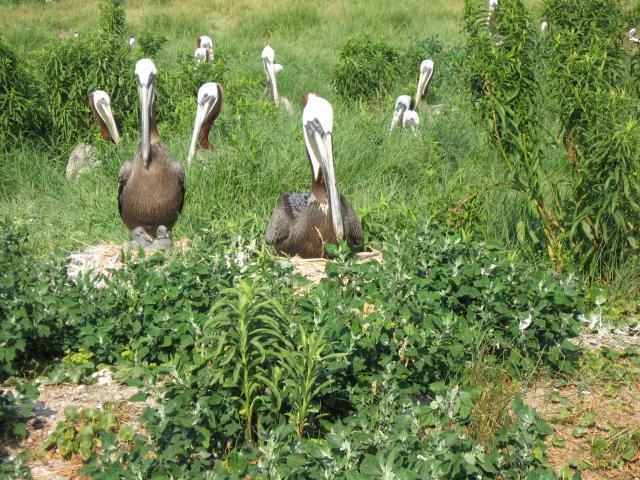For more than 25 years, Audubon North Carolina has managed a network of habitats along North Carolina’s coastal plain offering a haven for birds. With specialized habitats and protection from predators and human disturbance, coastal birds in our state have special places to thrive. Read on to learn more about the Coastal Sanctuary Program and the birds they protect.
With this blog series, we are taking a peak behind the curtain and sharing the secrets of the sanctuaries in North Carolina.
Along the Cape Fear River, Audubon North Carolina manages seven coastal sanctuaries that protect essential habitats for waterbirds and shorebirds. With diverse habitats ranging from sand and grass to forest and marsh, this network of islands attracts flocks of waterbirds by the thousands. Species like the White Ibis and Brown Pelican boast thriving populations today because of their breeding success at these sanctuaries.
Battery Island is an island along the lower Cape Fear River and one of Audubon North Carolina’s 96 Important Bird Areas. Audubon has protected and managed Battery Island since 1981 by planting trees for habitat enhancement, conducting long-term monitoring projects, and working to protect birds from human disturbance.
Several habitats are found at Battery Island including sandy beach, shrub thicket, forest and marsh offering preferred nesting habitats for birds. See a few of the birds recorded nesting at Battery Island over the past 30 years:
- White Ibis
- Tricolored Heron
- Great Egret
- Cattle Egret
- Snowy Egret
- Little Blue Heron
- Black-crowned Night Heron
- Glossy Ibis
- American Oystercatcher
- Seaside Sparrow
- Clapper Rail
Non-nesting species spotted at Battery Island have included Saltmarsh Sparrow, Nelson’s Sparrow, Bald Eagle, Northern Harrier and many shorebird species.
Audubon works with a number of conservation partners at each sanctuary to protect birds and their habitats. At Battery Island, partners include NC Wildlife Resources Commission, NC State Parks, Cape Fear Garden Club, and NC State University.
With sea level rise affecting the entire North Carolina coastline, Audubon is working with the Army Corps of Engineers and other conservation partners to maintain the Battery Island sanctuary.

Audubon has managed Ferry Slip Island since 1990. Audubon’s coastal team maintains posted signs to show that these places are off limits to the public, monitors nesting birds, manages diverse habitats, plus restores and enhances many of the sanctuary sites with dredged material. Audubon sanctuaries like Ferry Slip Island are also laboratories for scientific research that leads to a better understanding of birds and their habitats.
Ferry Slip Island is a manmade sanctuary and considered one of Audubon NC’s 96 Important Bird Areas. The island provides sand and grass habitat for nesting species including the Royal Tern, Sandwich Tern, Brown Pelican, Gull-billed Tern, Laughing Gull, and American Oystercatcher.
When the Army Corps of Engineers removes sand from the Cape Fear River, all of that material needs a place to go. For years, Audubon has worked with the Corps to distribute the dredged material in the most efficient ways that also create the best possible habitat for nesting waterbirds.
Audubon works with a number of conservation partners at each sanctuary to protect birds and maintain habitats. At Ferry Slip Island, partners include NC Wildlife Resources Commission, NC State University, UNC Wilmington, and US Army Corps of Engineers.
Click here to learn about more of our Cape Fear River sanctuaries.



